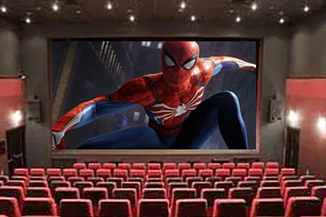Publisher: Supplier of LED Display Time: 2022-11-29 10:49 Views: 1428
The University of Texas has developed a foldable, bendable, and cuttable MicroLED display. Do you know what features it has? Next, Liancheng sent the editor to take everyone to take a look!
With advantages such as thinness, energy saving and high brightness, LED displays are widely used in various applications and products from brake lights to billboards, and LEDs have become an ideal light source for backlighting and displays in electronic equipment. With the development of technology and the advancement of applications, the size of current LED chips is getting smaller and smaller. The very popular Micro-LED concept emerged along this line of thought.

Figure 1. Flexible Micro-LED devices that can be twisted (left) or folded (right) (Image credit: University of Texas)
The chip size of Micro-LED can be made smaller than 2 microns. Through some "combinatorial" integration schemes, it can build any shape desired by the designer and provide higher resolution than other LEDs. In fact, the feasibility of this small-size solution also makes Micro-LED display panels suitable for various small-size devices such as smart watches. Of course, they can also be used in combination for ordinary flat-screen TVs or other larger displays. However, up to now, these LED chips of different sizes are still very brittle, and usually can only be used in some flat applications, or it has certain requirements for the curvature of the applied products.
Recently, researchers at the University of Texas reported that they developed a new method for fabricating foldable, bendable and cut-and-stick Micro-LEDs. The findings help pave the way for the commercialization of next-generation flexible wearable technologies. According to reports, the Micro-LED they developed based on this method can be transferred to clothes or even rubber substrates. From the verification results, even if the substrate has obvious wrinkle problems, it has no effect on the normal operation of the Micro-LED. In addition, the researchers say they can cut the developed Micro-LED products in half and continue to use them.
The researchers used a technique called remote epitaxy to develop the flexible LED device, which allows the researchers to grow a thin layer of LED chips on the surface of a sapphire wafer or substrate. Typically, such LED chips are retained on a wafer. However, in order to make such LED devices "detachable", the researchers added a non-stick layer to the substrate, which works in a similar way to using parchment paper to protect a baking sheet. With such a non-stick layer, the researchers could easily remove the LED chips. In fact, the functional layer the researchers added, made of a single-atom two-dimensional carbon material called graphene, prevents the new layer of LED chips from sticking back to the original wafer.
According to reports, this graphene material does not form a chemical bond with the LED chip material, so having it in the entire structure can introduce an additional intermediate layer that allows the LED to be peeled off from the wafer and stick to other surfaces. To verify the flexibility of the Micro-LED device, the researchers tested it in the lab by adhering the LED device to a substrate with a curved outer surface and twisting it during the subsequent test. , bending and wrinkling and other processing operations. In addition, they also cut the Micro-LED device. The results showed that the bending and cutting tests did not affect the LED's luminous quality and electrical characteristics.
According to reports, this curved Micro-LED device with very good flexibility has a variety of potential applications, including flexible lighting and display, smart clothing and wearable biomedical devices. From a manufacturing point of view, this manufacturing technology also provides designers with another potential alternative. After all, it allows designers to remove LED devices without destroying the wafer substrate on the underside of the LED. Here is a potential The advantage is that the wafer can be reused. In addition, the researchers say they have already applied this fabrication technique to other types of materials.
The above is the relevant introduction content of the collapsible, bendable and cuttable Micro LED display developed by the University of Texas compiled by Liancheng Xiaobian. Lianchengfa is a world-leading provider of LED display applications and solutions, as well as a national-level professional and special new small giant enterprise. The main business covers four major sections: "Smart City", "Cultural Tourism Commercial Performance", "Commercial Display Engineering", and "Content Technology". It has the world's leading automated production equipment, modern post-doctoral research laboratories and comprehensive sales and services. team. Friends who want to buy LED displays can also contact us Lianchengfa led display manufacturer, a big country brand, trustworthy!
Source: CINNO Research









